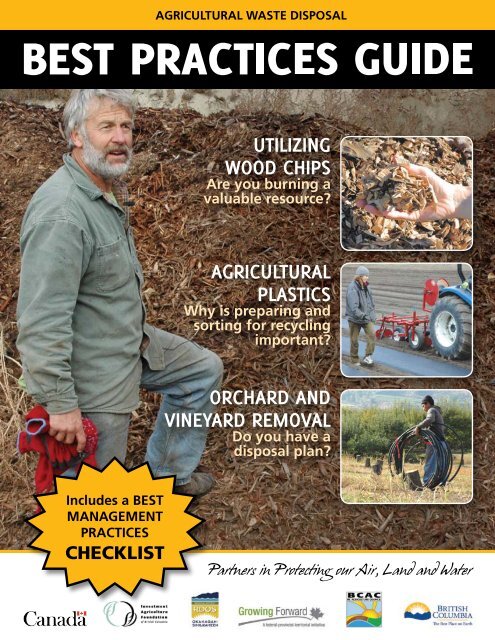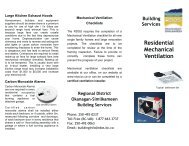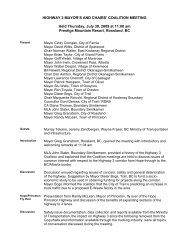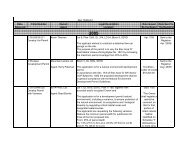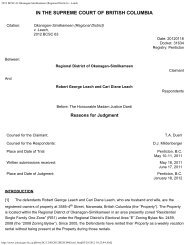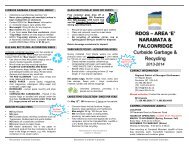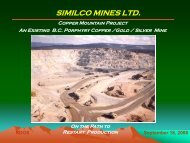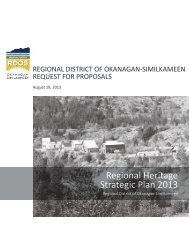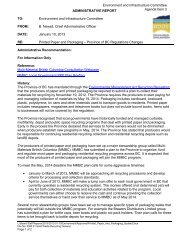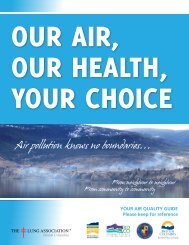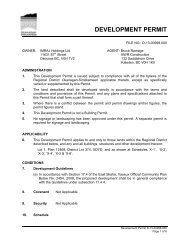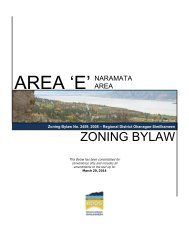Agricultural Waste Disposal - Agriculture
Agricultural Waste Disposal - Agriculture
Agricultural Waste Disposal - Agriculture
You also want an ePaper? Increase the reach of your titles
YUMPU automatically turns print PDFs into web optimized ePapers that Google loves.
About valley communitiesThe air quality in valley communities is affected by manyunique factors.•Temperature inversions result in smoke and other airpollutants being trapped in the valley bottoms, as warmupper air acts like a lid, keeping toxins from escaping.Inversions generally occur in the mornings year-round, butcan last all day during the winter months (mid-Novemberthru mid-March) when there are no up-drafts to carrypollutants out of the vallery bottom.• Poor wind dispersion creates a similar condition to atemperature inversion, because smoke and pollutants arenot carried away by normal winds, causing unhealthy airquality conditions in the valley.• Close proximity of farms and communities to each otherin a valley means what we put into the air immediatelyaffects our neighbours. Small particulate matter fromsmoke can enter homes and create unhealthy livingconditions.It is important that we do what we can during the winter tominimize air pollution (carpooling, burning only clean drywood, etc.), in order to ensure good air quality throughoutthe year.4BACK TOCONTENTS
1 2 3Example of (1) a poorly planned open burn (wet wood) polluting the valley, (2) The same burn affected by a temperature inversion.(3) Pollutants from the burn trapped and dispersing into the homes and community miles away.pollutants trapped invalley bottomBACK TOCONTENTS5
Concern over wood smoke• Science has changed dramatically over the last decade. It now showsus that smoke has significant public health effects, even at very lowconcentrations.• Exposure to levels previously thought to be “good” are now known tohave public health effects.• There are MORE THAN A HUNDRED known toxic substances found inwood smoke.• Wood smoke contains FINE PARTICULATE MATTER (PM2.5). These tinyparticles stay in the air longer and travel farther than larger particles(such as dust) and can penetrate indoors. They are also able to traveldeeper into the lungs, causing irritation and disease.• The BC Air Action Plan identifies fine particulate matter and groundlevelozone as the two most harmful contributors to air pollution in BC.• Young children, the elderly, and people with pre-existing lung orheart disease are most likely to be affected by the harmful pollutantsreleased into the air by wood smoke, however, healthy individualscan also suffer negative health effects.Current evidence shows that smaller particles(smoke) are more harmful than largerparticles (dust).course particlessettle in upperrespiratory systemfine particles(PM2.5) settle inlower respiratorysystem6All burning creates PM2.5 so, if you mustburn, BURN HOT AND DRY, producing minimalair pollutants.BACK TOCONTENTS
NEVER burn garbage or farm wasteIt is illegal to burn garbage, treated or painted wood, irrigation tubing,PVC pipe, tree support wire, chemical pails, fertilizer bags or similarmaterials. These release poisonous chemicals into the air,harmful to health.You must recycle, reuseor dispose of them atyour local landfill.Burning garbage at home orin the back yard has beena longstanding practice,but we now understandthat there are healthconsequences... so it’sTIME TO STOPBURNING.Garbage firessmolder and burnat temperaturesthat create dioxins,furans and manyother pollutantsthat fall back toEarth as particlesor in rain drops andcontaminate water andplants. They eventuallymake their way up thefood chain and into thefood we eat.BURNING GARBAGE canaffect your health morethan you think.BACK TOCONTENTSRULE OF THUMB: The only thing you shouldbe burning is CLEAN, DRY wood.7
Orchard/Vineyard removalResearch before you startSTEP 1: MAKE A DISPOSAL PLANA. HOW WILL YOU DISPOSE OF SURFACE MATERIAL?B. HOW WILL YOU DISPOSE OF WOOD WASTE?STEP 2: REMOVE AND SAFELY DISPOSEOF SURFACE MATERIALSA. SUPPORT WIRE (including clips or ties)B. IRRIGATION TUBING, SPRINKLERS, PVC PIPEC. TREATED WOOD SUPPORT POSTSSTEP 3: REMOVE AND DISPOSE OFTREES OR VINESA. EXCAVATIONB. WOOD SALVAGINGC. WOOD CHIPPINGD. WOOD BURNING8 BACK TOCONTENTS
STEP 1:Make a disposal planIt is important to consider your disposaloptions BEFORE you begin the orchard orvineyard removal process.A. HOW WILL YOU DISPOSE OF SURFACE MATERIALS?REUSE RECYCLE SELL/TRADE Can some materials be reused? If you do not need them,ask your neighbors or place an ad in your local paper oron the internet. Contact your local government or landfill for detailson recycling programs and obtaining bags to put youragricultural recycling into. if not reusing/recycling, contact landfill for preparationrequirements for bringing to the landfill.STEP 2:Remove and safelydispose of surfacematerialsIt is illegal and DANGEROUS TO BURNsurface materials.When burned, they release toxic chemicals into the airthat are harmful to our health and can contaminatewater, soil and plant surfaces.Once removed, prepare and separate these materials fordisposal or reuse:A. SUPPORT WIRE (including clips or ties)B. IRRIGATION TUBING, SPRINKLERS, PVC PIPE, TREE BANDSC. TREATED WOOD SUPPORT POSTSB. HOW WILL YOU DISPOSE OF WOOD WASTE?SALVAGE CHIP BURNBACK TOCONTENTS Find out if your local government offers a subsidisedchipping program. If there is no program, they maystill be able to provide you with a list of chippingcontractors or rentals in the area. Research the use of wood chips as a mulch, soilammendment, or in composting. Most landfills chip wood waste. Find out options forhauling to the landfill. Check with your local landfill fortipping fees on wood waste for chipping (if any). Ask around to see if anyone could use thewood (for firewood, chipping, etc.). Put an ad on the internet or in the papersadvertising the type and size of wood youhave available, or search the ads for woodsalvaging busiinesses. Consult the Environment Farm Plan Guide, callyour local Ag-Research Centre, or ask yourField Staff Advisor for more information. Contact all contractors involved to discussdisposal plan and removal methods. Research disposal options and grantfunding availability. Ensure excavators follow Best RemovalPractices.Many landfills, such as RDOSlandfills, do not charge a tippingfee on correctly prepared andsorted agricultural wire,plastic, treated wood supportposts andagriculturalwood wasteCall yourlocal landfillfor specificdetails ontheir program.9
A. Support wire• Take the time to remove wire, and the materials holdingthe wire in place.• Reuse metal clips or recycle them.• If plastic ties are not reusable, recycle or dispose of themin the garbage.• Roll wire lengths for ease of transportation, storage andrecycling.• If wire cannot be reused, roll and dispose of at your locallandfill where it is recycled or contact your local metalsalvager for drop off locations.• Wire spooling machines allow wire to be salvaged in amanner which makes re-use easier!• Tag and set aside any trees/posts that have wire or ametal post embedded in them. Separate from other treesduring excavation, as they cannot be burned or chipped.• Never burn wire or metal posts - it is illegal.POOR DISPOSAL(wire in pile withposts and trees)THIS WIRE HAS BEENSEPARATED AND ROLLED10BACK TOCONTENTS
B. Irrigation tubing,sprinkler heads, PVCpipe and tree bands• Remove black poly irrigation tubing and materialsholding the irrigation tubing in place.• If not reusing, prepare irrigation tubing for recyclingby removing sprinkler heads and all metal clampsand fittings; then cut the tubing into pieces and bagin heavy plastic bags that won’t tear or bag in woventote bags.• If not reusing sprinkler heads, ask other growers if interested inreusing and if not, bag and place in the garbage.• If there is no recycling in your area for irrigation tubing then disposeof in the garbage.• Check with local government office on whether there is a recyclingprogram for agricultural plastics in your area. If not, encourage one.• If removing PVC pipe (above ground or subsurface), it must beseparated from the tree wood material. PVC is difficult to recycle andtherefore must be tossed into the garbage if not reusing. It is illegalto burn PVC. Note: If there is a recycling market for PVC, all the gluedfittings must be removed and the PVC bundle tied. The glued fittingswould go into the garbage.• Remove plastic tree bands.• Never burn.REMOVEBACK TOCONTENTS11
C. Treated woodsupport posts• Remove posts before removing trees or vines; if impossiblethen ask your excavator operator to separate posts from treesor vines while excavating.• Pull the whole post rather than breaking off.• Reuse treated wood posts, or dispose of at your local landfill.• DO NOT CHIP TREATED POSTS.• Some landfills do not charge a tipping fee on <strong>Agriculture</strong>Treated Support Posts. Call your local landfill for details.• It is illegal and dangerous to burn treated wood as it contains arsenic.• <strong>Disposal</strong> of treated posts remains a challenge and growers areencouraged to research other post options for future plantings.• Removed posts can be resold or offered to other growers forreuse (large diameter posts are ideal for deer fencing).• If using metal/plastic posts, separtate from trees.• Never burn.THESE POSTS ARE READYFOR REUSE OR DISPOSAL12BACK TOCONTENTS
STEP 3:Remove and disposeof trees or vinesOnce surface materials have been removed and properlyprepared for disposal, proceed with removal of trees and vines.• Salvaging, chipping or hauling wood waste to the landfill where itis chipped are good options for disposal of agricultural wood waste.• The burning of agricultural wood waste is a majorcontributing factor to air pollution.• Wood waste is a valuable natural resource, which canhelp build healthy soil and conserve water. Researchand determine the needs of your soil to see if youcould benefit from using wood chips as a mulch or soilamendment.• Adoption of new practices is encouraged due to healtheffects from wood smoke and due to evolving regulations andnew restrictions on burning.Research the following processes and their benefits:A. EXCAVATIONB. WOOD SALVAGINGC. WOOD CHIPPINGD. WOOD BURNINGA. Excavation• Discuss your disposal plan with all contractors before work begins.• Before excavating, all surface materials must be removed. Remindexcavator to separate any trees identified with embedded wire ormetal post.• If salvaging wood, or chipping, check with those contractors as tohow they want the wood prepared before excavating. (Some salvagecompanies prefer to salvage the wood before the tree is excavated.)• If chipping with portable chipper or with a tub grinder, the correctplacement and preparation of the removed trees/vines saves timeand money.• Inform the excavator operator to remove most dirt and rock fromthe roots to avoid topsoil loss. Also, too much dirt and rocks willdull or damage the chipping blades or grinder teeth.• Reducing the amount of dirt on the wood also helps reduce theamount of smoke produced, should you choose to burn.• If hauling to the landfill, trees need to be cut to 6 foot lengths orshorter. Call your local landfill for specific requirements.• It is good practice to have the excavator fill the holes as they go, andset aside any subsurface PVC irrigation lines that have been unearthedin the tree removal.Remember to check with yourlocal government, packinghouse or growers associationfor information on wood wastedisposal programs and funding.BACK TOCONTENTS13
B. Wood Salvaging• There are various salvaging methods. Be sure to plan for each partof the tree: branches, trunk, and stump.• Remove small branches and pile in middle of each row, ready fordisposal by a portable chipper or mulcher (check to see if there is achipping program in your area). If not, renting a portable chipper isa good option.• Discuss with the contractor whether to haul the stumps to a landfillor bring in a tub grinder to grind both stumps and branches.• Check to ensure the tub grinding equipment can access yourproperty.• Contact your local landfill for information and requirements forhauling stumps to landfill.• Check with your excavator contractor BEFORE salvaging on howmuch tree trunk is needed (if any) to pull the roots out efficientlyduring the removal process.• If using the salvaged wood for firewood, it is importantto age/dry the wood before using for burning.Firewood should be stacked to allow good airflow, and then seasoned for at least 6 months.WHAT CAN THE WOODBE USED FOR?• fueling wood burning ovens,stoves and fireplaces• smoking or barbequing food• craftsmen use fruit wood tocreate furniture and householditems• larger trees can be milled forflooring14BACK TOCONTENTS
C. Wood Chipping• Check with local governments orFarm programs to see if they providea chipping service as an alternativeto burning or offer funding topurchase or rent chippers.• Some growers hire a local chippingcontractor or rent a portable chipper.•Transport wood waste to landfill whereit is chipped, and the chips used forcomposting/dust suppressant. Checkwith your local landfill on correctpreparation and fees (if any).• Different types of chippers areavailable to create the ideal size ofchips, depending on what the chipswill be used for:• as a mulch (1-2 inches long):weed control, pest control, waterretention, prevents soil erosion• added to compost (smaller chips,easier to break down): providessoil nutrition.• as a soil conditioner (very smallchips, or partially decomposed)break down and reintroduce organicmatter (carbon) into the soil• for landscaping (can be larger):use on pathways and roads toreduce dust and/or mud• for animal bedding or pellets• Unlike burning, wood waste is bestchipped when still green. Dry woodcreates too much dust and wearthe chipping blades down faster.• Before removing your trees/vines,check with your chipping contractorfor correct preparation of woodwaste for chipping.• Inform the excavator operator toremove most dirt and rock from theroots to avoid topsoil loss. Also,too much dirt and rocks will dullor damage the chipping blades orgrinder teeth.A FLAIL MOWER can be used by growersas a tractor attachment to create mulchfrom vineyard, orchard and berry cropprunings or from ground crops.A PORTABLE CHIPPER can be rentedor you can emply a local contractor.chippers vary in size. Some chippers canchip wood waste up to 15” in diameter.Chip size produced depends on thescreen, but should be between 1”-2”.A TUB GRINDER is the largest of theequipment used to grind, chop andshred wood waste. There may be one atyour local landfill. If required, contactlocal government to see if it is availableto come your site.NEVER CHIP TREATED POSTSThey contain arsenicwhich contaminates soilBACK TOCONTENTS15
UTILIZING WOOD CHIPS as a mulch• Spread wood chips approximately 2” (5cm) thickin order to:prevent soil erosionreduce weed growthconserve/retainwatereventually add nutrients to soil• Check with your local <strong>Agriculture</strong> Research Stationfor detailed advice on how to best use wood chipsas a mulch.• Consult the BC Environmental Farm Plan Guide formore information.NOTE: Avoid spreadingmulch immediately aroundthe tree, as the graft unionmust not be buried.THE IDEAL SIZEOF WOOD CHIPSFOR USE AS AMULCH IS 1”–2”(2.5 - 5cm).IT IS IDEAL TO SPREAD WOOD CHIPS WHERE THE ROOTS ARE MOSTLIKELY TO BE, IN A 3-6 ft (1-2 metre) STRIP WITHIN THE ROWS.16BACK TOCONTENTS
UTILIZING WOOD CHIPS in compost assoil conditioner and amendment• Adding wood chips to your compost and, oncedecomposed, spreading it back onto your crops helps toadd nutrients to the soil.Learn more online or ata local workshop aboutcomposting for healthy soil.COMPOST PILE• Wood chips can be added directly to the soil to build carbonrichsoil. Very small chips or partially decomposed chips arerecommended.• Some growers add nitrogen to the chips before working the chipsinto the soil.• Adding wood chips to soil can also help to reduce erosionand improve soil structure.• Check with your local <strong>Agriculture</strong> Research Station fordetailed advice on how to best use wood chips to enhanceyour soil.• Compost or mulch prunings, nursery crop foilage, culledplants and/or culled fruit.• Consult the BC Environmental Farm Plan Program Guide formore information on building heathy soils.• Find out if there are composting or soil nutrition coursesavailable in your area or online.For additional composting info, see page 24 of this guide.COMPOST PILECOMPOSTING =NUTRITION FOR SOILBACK TOCONTENTS17
UTILIZING WOOD CHIPS for landscaping and dust suppressant•Spreading wood chips on pathways, roads and hillsides helpsreduce dust and mud.• A ground covering of wood chips prevents soil erosion.UTILIZING WOOD CHIPS for bedding• Wood chips are a popular choice for livestock bedding, dueto their absorbent nature.• It is recommended that wood chips are stored andused a minimum distance from a water source, to avoidcontamination of the water through leaching.IMPORTANTDo not use woodwaste that may contain antisapstain chemicals,wood preservatives or fire retardation chemicals. Woodwastecontaining these chemicals can affect livestock, wildlife and fishthat come into contact with the treated wood waste or leachate.**The Canada-British Columbia Environmental Farm Plan Program Reference GuideUTILIZING WOOD CHIPS for pellets• Fruit wood pellets are often used in barbeques and ovens.• They burn hotter and longer than other wood varieties, andtend to give a unique flavour to the food.• Distributed to manufacturers in the food industry or directlyto restaurants.• Also used as heat source in wood stoves.• Ask salvaging companies who to contact in order to haveyour wood chips made into pellets.18BACK TOCONTENTS
D. Burning Wood <strong>Waste</strong>• BEFORE BURNING check local municipal, regional, and provincialbylaws and regulations to see if burning is permitted in yourarea, and if so, check restrictions/requirements (see pg.21).• Valley communities have poor wind dispersion and temperatureinversions, which cause pollutants such as smoke to collect inthe valley bottoms.• If you choose to burn, make sure the pile only contains clean,dry, untreated wood. NEVER BURN painted or treated wood,PVC pipe or garbage.• Growers must tell the excavator operator to remove most soiland rock from the roots (soil left in the roots will create moresmoke pollution).•Pile tree wood waste piles for sufficient airflow in order toachieve a hot burn with little smoke. Ensure fire is out by sunset.• Dry wood waste before burning (wet wood creates moresmoke pollution). Stumps take longer to dry.• Burning wood waste is a major contributor to air pollution, awaste of a valuable natural resource, and kills soil under theburn site... consider alternatives.• Alternatives include chipping, seasoning the material, milling(ie: for flooring) or taking to the landfill where it is chipped (somelandfills do not charge a tipping fee on agricultural tree waste).See bcairquality.ca/topics/rcbc-alternatives.html• Organic growers must meet the disposal criteria for organicstandards in order to keep their certification.• Avoid burning if grapes or other neighbouring crops have notbeen picked. Your burn could cause smoke and ash damage tothe fruit and pose a health hazard to orchard/vineyard workers.• If using curtain or trench burning, check with Provincial OpenBurning Smoke Control Regulations first. Contact contractorswho specialize in this process to see if it is workable on yoursite. If curtain burners are not operated correctly, they willcreate alot of smoke.THIS PILE OF WOODWASTE IS STACKEDWELL FOR DRYINGCheck your local bylaws to see if burningis allowed, and for required wood dryingtime in your area.REMEMBER: hotter burn = less smoke = less pollutionBurn only dry, clean, untreated, unpainted wood.BACK TOCONTENTS19
Air Curtain BurnersBefore using an Air Curtain Burner or conducting any typeof open air burn, consult the Provincial Open BurningSmoke Control Regulation and local burning bylaws• The operating principle of the air curtain burner is the introduction ofcontrolled high velocity air across the upper portion of a combustionchamber in which clean wood (ie. wood waste from land clearing) isloaded. The powerful curtain of air created in thisprocess traps unburned particles (smoke) under thecurtain where it is re-burned.• The burner is a large ceramic-lined metal firebox thatsits on the ground. Some require set up, while othersare completely self-contained.• A diesel operated fan mounted outside the box blowsair along a tube running along the top of the burner.(see diagram) The air is directed at high velocityacross and then down into the firebox, creating highertemperatures for a much faster and cleaner burn. Thecurtain of air acts like a lid trapping and forcing smokeand particulate back into the firebox.• A puff of smoke is produced as wood waste is loaded inside the box dueto the air curtain being broken, then quickly, the smoke stops as the aircurtain closes trapping most of the particulate and smoke below.High velocity curtainof air traps smokein firebox to bere-burned:• To keep the fire burning smoke-free, fuelloaded into the firebox needs to becontrolled carefully.• Curtain burners should beoperated by an experiencedoperator to ensure a smoke-freeburn. When a curtain burneris operated correctly, all thatis visible is hot gas escapingthrough the air curtain.• To view air curtain burners inoperation, visit YouTube online andsearch for “air curtain burners”.For additional resources on landclearing alternatives to open burning,view YouTube videos on trenchburners, forestry tillers, soil stabilizerattachments, mulchers and rock andstone crushers.Land Clearing• Before removing trees, research bylawsand provincial/federal regulations onremoval, then CREATE A DISPOSAL PLAN.• Research various disposal options;salvaging, chipping (see pg.14,15), fulltree mulching, local saw mills and/orlog home builders.• Check with your local compostingfacility, many accept wood wastewhole or chipped for composting.• If burning is the only option and ispermitted in your area, consider usinga curtain burner, but first check localbylaws and Provincial Open BurningSmoke Control Regulations.20Wood waste is avaluable resourceBACK TOCONTENTS
VENTILATION INDEX (VI)• BEFORE BURNING, check local bylaws for burningrestrictions and Ventilation Index requirements.• A Ventilation Index is an estimate of how well smoke SHOULDbe carried away from the surface (the valley bottom).• Because it is an estimate, the reported VI is a generalforecast. Specific venting forecasts are available for a fee ifdetailed data on your location is required.• Use the VI as a tool, but do not rely soley on its forecast,as many other factors are involved in determining whetherconditions are good for burning.• The Provincial Open Burning Smoke Control Regulationstates that the Ventilation Index must be “good” to conductan open burn. Some local bylaws burning requirements aremore stringent.• It is recommended that open burns are conducted ondays when the Ventilation Index forecast is 65 or greater.• In some areas, the VI and Air Quality forecast must both begood in order to burn. Check your local bylaws before burning.• The higher the Ventilation Index, the better the smokewill disperse.• The VI is generally higher in the afternoons than in themornings. Venting is better in the afternoons.• The key to minimize smoke is to burn small, hot fires,build piles to ensure good air flow, and be sure the fireis out by sunset.• Clear, cold, calm winter days are poor venting days, as thereare no up-drafts to carry smoke away from the surface.• For burning season, mid March and April and midOctober have the highest number of good venting days.• Poor burning practices produce smoke.OPEN BURN CHECKLIST1. CONSIDER THE ALTERNATIVES2. FOLLOW LOCAL AND PROVINCIAL BYLAWSCall your local government for information on localburning, smoke or fire safety bylaws and to obtainburning permits.The Provincial Open Burning Smoke ControlRegulations (OBSCR) apply to all areas.In BC, offenders of the OBSCR can be reportedto the toll free hotline (24hr) at 1-877-952-7277 oronline at www.env.gov.bc.ca/cos/rapp/rapp.html3. CHECK THE VENTILATION INDEX (VI)For BC, the VI Smoke Control Forecast is availabletoll free at 1-888-281-29924. REPORT BURNING PERMIT NUMBERBefore starting your burn, you must call in yourburning permit number to activate it. The number tocall will be on your permit.Areas without a local government burning bylaw mayrequire a burn registration number from the Ministryof Forests, Lands and Natural Resource Operations.Call Toll Free: 1-888-797-17175. CONDUCT A SMALL TEST BURNEven though the VI is good on the day you areconducting a burn, it is important to test localconditions to ensure the smoke is not travellingalong the ground through residential or school areas.6. BURN ACCORDING TO BEST MANAGEMENT PRACTICESBACK TOCONTENTSThis photo demonstrates poor wind dispersion and poor burning practices, creating a smoke loadon the valley bottom and releasing a large amount of pollutants into the air. (See About ValleyCommunities, pg 4)21
Prunings: ground crops or yard wasteThe burning barrel is no longer an acceptable method ofdisposal for yard or farm waste (Prohibited in some areas).• PRUNINGS can be left on the ground and flail mowed or chipped.You can also haul prunings to the landfill or compostingfacility (Some landfills do not charge tipping fees on properlyprepared agricultural wood waste, such as the RDOS).• LEAVES AND GRASS CLIPPINGS Never burn as they will smokeand smolder creating significant smoke pollution. Mulch,compost or deliver to your landfill where they will be utilizedfor compost. Search “Grass recycling” on the web for tips onutilizing grass clippings in lawn care.• GROUND CROPS can be mulched and worked back into thesoil to add nutrients for new crops. They are also a valuablecontribution to a compost pile.• VARIOUS MULCHERS (flail mowers) are available to attach tothe tractor to mulch prunnings. PORTABLE CHIPPERS are alsoavailable at equipment rental outlets.• If mulching, move branches to the center of the rows anddistribute material evenly to avoid clogging of the flail mower(clogging could damage mower equipment and the tractor).• Drive slowly over pruned branches (driving too fast will leavelarge wood pieces).• Heavy duty mulchers will mulch prunings up to 3” in size.•If chipping prunings, they can be laid so the butt ends arefacing one direction for faster chipping.• Or they can be gathered and placed in a long pile for chippingwith a larger chipper.•Piling prunings takes more time to chip as each branch wouldhave to be pulled out of the tangled pile.• Grants may be available to purchase mulchers or chippers.Check with your grower association and with the EnvironmentFarm Plan Program.• Some growers may rent out their mulching mowers or docustom mowing. Tree fruit cooperative newsletters is anexample of where growersmay advertise.ORGANICMATERIALBEING WORKEDBACK INTOTHE SOILCORN FIELDCOMPOSTINGBAGGED forcurbside pickup22 BACK TOCONTENTS
Prunings: berry growers, Hazelnut orchards• The amount pruned and size of prunings varies with each type ofcrop however the disposal options for all are the same.• Prunings are a valuable resource when mulched, chipped, compostedand fed back to the soil. (See page 16-18 of this guide.)• BERRY CROPS such as Blueberry and Raspberry caneprunings average in size of 1/4” to 3” and are flailmowed or chipped.• The smaller pruning canes lying in the field aremulched with the tractor lawn mower or a flail mower.• The larger pruning canes are chipped and chips placed along thepruned bushes.• HAZELNUT TREES grow suckers at the base of the tree. These areclipped off and can be mulched or chipped. Weavers mayalso want to use them for basket making.• Larger branches can be chipped. (See page 15 of this guide.)• Larger prunings, when dried, are sometimes used for fire woodin home heating, campfires or sold to food industries.• For information on mulching prunings with a Flail mower, seepage 22 of this guide.• CHIPPING PRUNINGS: There are now chippers on the market thatare self-propelled that will fit in between crop rows. (See page 15of this guide.)• HAULING: Growers can haul prunings to a localcomposting facility.• Check the internet or phone book for localcomposting facilities.• Check with local landfills on specifics for hauling to the landfill.• Many landfills now chip wood waste and compost.• BURNING IS NOT RECOMMENDED for prunings as they are easilymanaged with a flail mower and or chipper. However, If choosing toburn; ensure prunings are dry and stacked for sufficient air flow toproduce a hot, smoke free fire which will reduce the level of smokepollutants. (See pages 4-6 and pages 19-21 of this guide.)• DISEASED MATERIALS: It is best to find out what the guidelines are foreach individual disease and speak with a plant pathologist beforechoosing a disposal method for diseased materials. When in doubt,landfill burial at your local landfill is best.HAZELNUTpruningsPrunings and larger wood wasteare best chipped when greenand not overly dry. Chipping dryprunings and larger wood wasteis harder on the equipment andcreates dust.PRUNINGSCHIPPEDCOMPOSTEDOR USED ASMULCHBACK TOCONTENTS23
Nursery <strong>Waste</strong>/CompostingPRUNINGSand CLIPPINGSLEAVESPlant wasteis a valuableresource whencomposted.POTTED PLANTSand TREESDIRTNUTRIENT-RICHCOMPOST• Compost is food for the soiland reduces reliance onpetroleum-based fertilizers,pesticides and herbicides.• Professional landscapers,arborists dropping offmaterials to this nurseryand placing in a windrow,which is later chipped with a grinder.• First stage, once materialhas been chipped.• “Hog Fuel” (wood wastefrom mills) is used at thisnursery to build pottingmixes, when mixed withplant residue compost.• During the compostingprocess, monitoring thetemperature is important,as is turning/mixing thecompost pile.• Special thermometerscome in different lengths.At this facility, a four footthermometer is used to measure temperatures in thecentre of the windrows.“HOG FUEL”• Raw hog fuel (left) and completed compost (right).• Compost piles at two stages(one on the left is newer).• Keep records and monitorthe pile(s) carefully atvarious stages.• For additional compostinginfo, see page 17 of thisguide.24 BACK TOCONTENTS
Nursery <strong>Waste</strong>/CompostingBefore choosing a disposal method for diseasedmaterials: It is best to find out what the guidelinesare for each individual disease and speak with aplant pathologist. When in doubt, landfill burial atyour local landfill is best.NURSERY PLASTICS – there is value in recyclingplastics, as it reduces landfill waste, preservingthe life of landfills.It is important to do our part and recycle plastic.Some nurseries utilize bailers, while othersbundle tie or bale. (See page 26-33 for moreinformation on <strong>Agricultural</strong> plastics recycling.)NOT COMPOSTING ON SITE? Deliver nursery plant waste to othercompositing sites – check the internet for composting companiesnear you.NO TIME TO COMPOST? Look into contracting your compostingoperations to Composting Specialists.DON’T KNOW HOW TO START? Consult composting experts, start bychecking with Ministry of <strong>Agriculture</strong> office. Search the web.• Compost piles in dryer climates can get too hot or too dry andrequire irrigation to manage the composting process and toavoid combustion.• In wetter climates, adquatemoisture still must bemaintained at 50%.Irrigation may not berequired in wetter months.• Constant monitoring isthe key to successfulcomposting!CHECKINGLAYERSUNWANTED OR OLDER WOOD PALLETS – contactlocal composting facilities to see if they willtake them. Many composting facilities willtake clean wood waste, including unpaintedpallets. Discard painted pallets at your locallandfill (it is illegal to burn any painted ortreated products).TOO DRYTURNING THE PILEBACK TOCONTENTS25
<strong>Agricultural</strong> Plastics RecyclingCheck whether your area has an Ag-Plastics recycling program.If not, encourage one! If there is, contact them for specificdetails on preparing your plastic for recycling.To ensure a successful recycling program for <strong>Agricultural</strong>plastics, please follow these guidelines:CHEMICAL AND FERTILIZER CONTAINERS• Return to dealer (see page 33)ALL OTHER AG-PLASTICS• Plastics must be emptied of all contents.• Plastics must be as clean as possible, dry and sorted.• Place materials of the same plasticproduct in its own Ag-Plasticcollection bag (See following pagesfor more details) For those living inthe RDOS region, call or visit yourlocal landfill for your Ag-Plasticcollection bags.• Whether provided or purchased,clear bags must be at least 3mmin thickness, so they do not teareasily. If you have woven toteson your farm, they can also beused for collection.• Do not overfill the collection bagsas they must be tied shut (Usezap ties or twine - no wire).• Deliver to your collection site, to the Ag-recycling collectionarea and place in correct category (look for signage).• Keep Ag-Plastic Recycling Area sorted and free of garbage.• To better manage space in designated collection area, placefilled bags up against other bags.DO NOT HIDE GARBAGE!Tractor belts, metal, household siding,insulation, paint, partly filled fertilizerbags, chemicals, empty chemicalcontainers or household garbagecreate a health risk for those handlingthe materials and damage the plasticprocessing equipment.Ag-Plastic Collection bags must beclear and at least 3mm in thickness.26 BACK TOCONTENTS
LIVESTOCK FEED PLASTICSNO HAY WITH TWINECLEAN, SORTED TWINESEPARATE BALENETTINGFROMSTRAPPINGBALE TWINE• This easy removal method keeps twine clean and won’t break apartyour bale:• hold knot and cut twine close to knot• holding the knot, pull twine through bale• Clean off hay or debris (recycler will REFUSE if it is not totally hay-free).• Store twine in the Ag-Plastic collection bag or a clean Super Sac.• Tie the filled bag closed, so that none of the contents spill out.• Deliver your clean, sorted and tied full bags to your local landfilland place in the correct collection area.SILAGE WRAP/BUNKER SILO COVER• Remove most contaminants.• If wet, hang to dry.• Large pieces can be folded then rolledup tight and bagged. The folded & rolledmaterial can also be bundle-tied, butmust be tied well so as not to come apart.• Smaller pieces of silage wrap can be bagged. Don’t overfill. Tie thebag closed.• DO NOT mix other materials with silage wrap or with bunker silo cover.• Deliver your clean, sorted and tied bags or bundles to yourcollection site and place in the correct collection area.BALE NETTING• Must be bagged separately from strapping, twine, wrap or any othermaterial.• Netting must be clean. If the straw cannotbe removed, it must go to the landfillgarbage area.FEED BAGS• Bag separately for recycling.TOTE BAGS• May use as collection bag, or recycle other totes into a tote.BAGGEDCLEAN ANDDRYSILAGE IN WRAPBACK TOCONTENTS27
NURSERIES and GREENHOUSES• All film plastics must be sorted, fairly clean, and dry.• All plastic bags must have contents emptied and befairly clean before bagging or baling.• Separate clear greenhouse film from colored filmplastics.• Greenhouse film can be baled or bundle-tied well, andkept from UV exposure to keep it from degrading andgetting contaminated/dirty.• Trimmings and smaller pieces of film can go into Ag-Plastic collection bags and be taken to collection site.• Thin film, such as shrink wrap, should be bagged/baledseparately.• Use cardboard at ends of bale to secure.• Commercial operations may want to deal withplastic processors directly, as there may be financialcompensation for recycling.PLASTIC TOO DIRTYSMALLER PIECESCAN BE BAGGEDCLEAN ANDBALEDCLEAN, CLEAR FILMMADE INTO PELLETSBALER28BACK TOCONTENTS
PLANT POTS and TRAYS• MUST BE CLEANED, SEPARATED AND BAGGED.• Soil must be removed before recycling, as it damages the recyclingequipment.• Do not overfill Ag-Plastic collection bags as they must be tied closedso the contents do not spill out.• It is IMPORTANT to sort different types of potsand trays into rigid or flimsy plastics, as wellas into colors. This allows the recycler tocreate colored pellets.SEPARATE INTOBAGSCLEAN, SORTEDCLEAN, SORTEDCLEAN, SORTEDBAGGEDDO NOTLEAVE DIRTIN TRAYSOR POTSSORT RIGIDFROMFLIMSYCLEAN, SORTEDBACK TOCONTENTS29
ORCHARDS/VINEYARDSBLACK POLY IRRIGATION TUBING•Remove sprinkler heads. Alsoremove metal clasps and anymetal fittings (metal willdamage plastic processingequipment).• Cut tubing into lengths inorder to fit into Ag-Plasticcollection bags for recycling.• Tie bags shut so contentsdo not spill out.• Rubber watering hoses, such asthe green watering hoses, are notaccepted – place those in garbage.DO NOT MIXPVC, BLACK TUBINGAND T-TAPEDO NOT INCLUDEGARDEN HOSEST-TAPE (drip irrigation tape)•Separate t-tape and bag for recycling.• Deliver your sorted and tied full bags to collection site and place inthe correct collection area.WHITE PVC PIPE• Recycling PVC is a difficult process. Check with your local collectionsite FIRST to see if they are able to accept PVC pipes beforeproceeding with preparations for recycling.•Check with other growers to see if they are interested in reusing.• Separate pipes from tree or posts.• For recycling, all metal and glue fittings must be removed andplaced in landfill garbage area.• If you cannot remove glue and metal fittings, the entire PVC pipemust go to the landfill garbage area.• All other PVC materials, including household vinyl siding, are NOTacceptable through Ag-Plastic Recycling programs.PLASTIC TIES and TREE BANDS•Remove and bag separately.SEPARATEBAG NOT TIEDSHUT –CONTENTSSPILL OUTREMOVESPRINKLERHEADS30 BACK TOCONTENTS
CLEANNETTINGVINEYARDSNETTING• Netting must be free of vines, foliage. If it is not, it must bedisposed of in the garbage.• Separate and bag netting by color in heavy duty bags (not garbagebags) or provided Ag-Plastic collection bags.• Tie the bag closed.FILM PLASTICS FROM GROW TUBES• Remove plastics from grow tubes.• Separate rigid and flimsy into separate Ag-Plastic collection bags.NETTINGCONTAMINATEDWITH FOLIAGEBLADDER BAGS• Not part of the RDOS Ag-Plastic recycling program.• Commercial operations – deal with plastic processors directly, asthere may be financial compensation for recycling.• Rinse, dry, cut and fold large sheets into manageable sizes.• Do not leave loose, as they collect dirt and other contaminants.• Discuss preparation details and shipping with plastic processor.FILM PLASTICS SURROUNDING BLADDER BAGS• Sort clear, black and colored film and bag or bale separately.TOO MANY VINESIN NETTINGBLADDER BAGSLOOSE ANDUNCLEANSEPARATECLEAN NETTINGREADY FOR BAGSCUT and FOLDEDBACK TOCONTENTS31
GROUND CROPS/BERRIESBLACK GROUND COVER• Only remove ground cover when land is dry, not wet.• To remove dirt from ground cover row ends:a) Poke hole with hand through the plastic. Move handunderneath the plastic to lift and shake off excess dirt, orb) Cut off ground cover row ends and areas that are caked withdirt and dispose of any dirty or contaminated plastic separatelyin the garbage, to be landfilled.• Shake dirt off as you collect ground cover from the rows for recycling.• If ground cover cannot be cleaned of crop residue, it must be landfilled,not recycled.• Separate T-tape or other irrigation product from ground cover plasticand bag ground cover in its own Ag-Plastic collection bag.• Do not overfill the Ag-Plastic collection bag, as the bag must be tiedclosed to avoid spillage.T-TAPE• Bag T-Tape separately in its own Ag-Plastic collection bag.SHAKE DIRT OFFBERRY CRATES• Sort by color and type.• Bag or bundle-tie well, so theydo not fall apart.GROUND COVERT-TAPEGRAIN BAGS• Empty and clean for recycling• Large pieces can be bundle-tied, but mustbe tied well, so as not to fall apart.• DO NOT mix other materials with grain bags.• Deliver clean, sorted and tied bags toyour collection site.SEPARATEBAG GROUNDCOVERBAG T-TAPE32BACK TOCONTENTS
AGRICULTURAL CHEMICAL CONTAINERSNEVER BURN!RETURN CLEAN,WITH CAPS & BOOKLETSREMOVEDNEVER BURN!RECYCLED SEPARATELY FROM ALL OTHER AG-PLASTICS• All empty chemical containers must be returned CLEANED to your growersupply store or point of sale.• CLEANED means rinsed until allresidue is removed (More thanthree rinses is needed).• Rinse containers with caps on toavoid accidentally splashing andthis also removes the residuefrom the cap.• Cap and booklet are then placedinto the garbage and landfilled.• Important to RINSE immediatelywhen the containers areemptied so that the residuesare dumped into your sprayer.Never allow the chemical todry to the walls and bottom ofcontainers.• It is very important to removeall the residue from thecontainers to ensure safehandling for recyclers.• It is illegal and dangerous to burn any type of plastic, includingchemical containers and bags.• It is also now ILLEGAL TO BURY chemical containers. They are notaccepted at landfills as they are a recyclable product and must bereturned to your grower supply store.• Until you are ready to return the cleaned chemical container back topoint of sale, STORE IN A LOCKED SITE or away from sites where thecontainer may accidently be reused for other purposes. This is a worker/farm safety practice. Not following this practice can result in a failedfood safety audit.• Chemical bags should be rinsed directly into the sprayer and thentossed into the garbage and landfilled. Never burn.• It is illegal to landfill chemicals whether in a bag or in a container.Unused chemical and/or fertilizer containers and bags MUST be storedin a locked storage shed until a collection occurs in your area.Please do your part and recycle emptychemical/pesticide containers by rinsinguntil all residue is removed, remove capand booklet and return clean containerto your farm supply store. Caps from thecontainers must go into the garbageand not burned.BACK TOCONTENTS33
Orchard/Vineyard removalBEST MANAGEMENT PRACTICES CHECKLIST341. REMOVE SURFACE MATERIALS AND DISPOSE OF SAFELY (ILLEGAL TO BURN)It is illegal and dangerous to burn surface materials because whenburned they release toxic chemicals that are harmful to our health andcan contaminate water, soil and plant surfaces.a. Safe <strong>Disposal</strong> of Wire: Take the time to remove wire, and the materials holding the wirein place. Reuse metal clips or recycle them. If the plastic ties are not reusable, recycle or dispose of them inthe garbage. If wire cannot be reused, roll and dispose of at your local landfillwhere it is recycled or contact your local metal salvager for dropoff locations. Wire spooling machines allow wire to be salvaged in a mannerwhich makes re-use easier. Tag and set aside any trees/posts that have wire or a metal postembedded in them. Separate from other trees during excavation,as they cannot be burned or chipped. Wire is coated with a thin layer of another metal such as lead Never burn wire or metal posts - it is illegal.b. Safe <strong>Disposal</strong> of Irrigation Tubing & Sprinkler Heads & PVC Pipe: Remove black poly irrigation tubing and materials holding theirrigation tubing in place. If not reusing, prepare irrigation tubing for recycling by removingsprinkler heads and all metal clamps and fittings; then cut thetubing into pieces and bag in heavy plastic bags that won’t tear orbag in woven tote bags. If not reusing sprinkler heads, ask other growers if interested inreusing and if not, bag and place in the garbage. If there is no recycling in your area for irrigation tubing thendispose of in the garbage. Check with local government office on whether there is a recyclingprogram for agricultural plastics in your area. If not, encourageone. (See page 26-34 for details) If removing PVC pipe (above ground or subsurface), it must beseparated from the tree wood material. PVC is difficult to recycleand therefore must be tossed into the garbage if not reusing. It isillegal to burn PVC. Note: If there is a recycling market for PVC, allthe glued fittings must be removed and the PVC bundle tied. Theglued fittings would go into the garbage. Remove plastic tree bands. Never burn.c. Safe <strong>Disposal</strong> of Treated Wood Posts: Remove posts before removing trees or vines; if impossible thenask your excavator operator to separate posts from trees or vineswhile excavating. Pull the whole post rather than breaking off. Reuse treated wood posts, or dispose of at your local landfill (donot chip treated posts). Some landfills do not charge a tipping fee on <strong>Agriculture</strong> TreatedSupport Posts. Call your local landfill for details. It is illegal and dangerous to burn treated wood as it containsarsenic. <strong>Disposal</strong> of treated posts remains a challenge and growers areencouraged to research other post options for future plantings. Removed posts can be resold or offered to other growers for reuse(large diameter posts are ideal for deer fencing). If using metal/plastic posts, separtate from trees. Never burn.2. REMOVAL OF TREE, GRAPE VINE or BERRY CROP WOOD WASTEWood waste is of value while the burning of agricultural wood wasteis a major contributing factor to air pollution and a waste of a naturalresource. Adoption of new practices is encouraged due to healtheffects from wood smoke and due to evolving regulations and newrestrictions on burning.Salvaging, chipping or hauling wood waste to the landfill where it ischipped are good options for disposal of agricultural wood waste.a. Research The <strong>Disposal</strong> Options: Salvaging, Wood Chipping, Burning Call your local government, packing house and grower associationto ask what disposal options are available, if funding is availablefor removal and if there are any chipping programs or programsproviding funding to purchase chippers. Put an ad on the internet or in the papers advertising the type andsize of wood available. Speak with an Environmental Farm Planner, field staff working withthe Ag-research centres.b. Wood Salvaging: Firewood; (important to dry at least 6 to 8 months before using) Furniture makers, local artists. Larger trees can be milled for flooring. Wood salvaging businesses who sell dried fruit wood or dried fruitwood chips to food companies to smoke foods, to restaurantsusing fruit wood for cooking, to businesses compressing woodchips for barbequing or heating or to other provinces to be usedfor home heating. If salvaging, check with your excavating company on how much ofthe tree is needed for excavation (minimum trunk height). There are various salvaging methods. Be sure to plan for each partof the tree: branches, trunk, and stump. Remove small branches and pile in middle of each row, ready fordisposal by a portable chipper or mulcher (check to see if there isa chipping program in your area). If not, renting a portable chipperis a good option. Discuss with the contractor whether to haul the stumps to a landfillor bring in a tub grinder to grind both stumps and branches. Check to ensure the tub grinding equipment can access yourproperty.c. Wood Chipping: Growers must inform their excavator operator to remove most dirtand rock from the roots. Chip size is best about 1’ to 2” in size.BACK TOCONTENTS
Benefits of using wood chips as a mulch: weed control, waterretention, prevent soil erosion, breaks down and feeds the soil. Chips can also be used as a soil amendment or added to compostpile (to learn more on building healthy soils, see back cover foradditional resources). Some local governments provide a chipping service as analternative to burning. Some companies buy dried wood chips for various food processingmarkets. Chips can also be used for landscaping, dust suppressant on roads. For more information see the BC Environmental Farm Plan Guide,call your local Ag-Research Centre, or ask your Field Staff Advisor. There are various sizes of portable chippers and tub grinders available. Many landfills now chip wood waste, and some landfills do notcharge a tipping fee on correctly prepared agricultural wood waste.Call your local government or landfill for more details.d. Wood Burning: Growers must inform the excavator operator to remove most soiland rock from the roots (Soil left in the roots will create moresmoke pollution, Burning destroys the health of the soil). Pile tree wood waste piles for sufficient airflow in order to achievea hot burn with little smoke. Never add other materials such aspainted or treated wood, garbage etc. to the wood burning pile. Dry wood waste before burning (wet wood creates more smokepollution). Stumps take longer to dry. Avoid burning freshly removed stumps and roots as these release asignificant amount of smoke. Alternatives include chipping, seasoningthe material, or taking to the landfill where it is chipped (somelandfills do not charge a tipping fee on agricultural tree waste). Valley communities have poor wind dispersion and temperatureinversions where smoke collects in the valley bottoms – Checklocal municipal, regional, and provincial bylaws and regulationsbefore burning. Organic growers must meet the disposal criteria for organicstandards in order to keep their certification. Avoid burning if grapes or other neighbouring crops have not beenpicked. Your burn could cause smoke and ash damage to the fruitand pose a health hazard to orchard/vineyard workers.e. Wood Smoke: Is caused by the incomplete combustion of wood and consistsof a complex mixture of gases and very small particles calledparticulate matter (PM2.5). It is a significant contributor to air pollution. Emissions from wood burning can trigger congestion, coughs,headaches, and eye and throat irritation, even in otherwise healthypeople. It can also increase the severity of existing conditionssuch as asthma and emphysema. People most at risk are children,the elderly and those suffering from chronic respiratory andcardiovascular disease.f. Excavating: Discuss your disposal plan with all contractors before work begins. Growers must inform the excavator operator to remove most dirtand rock from the roots. Before excavating, all surface materials must be removed. Remindexcavator to separate any trees identified with embedded wire ormetal post. If salvaging wood, or chipping, check with those contractors howthey want the wood prepared before excavating. (Some salvagecompanies prefer to salvage the wood before the tree is excavated)(If chipping, correct preparation saves time and money) It is good practice to have the excavator fill the holes as they go,and set aside any subsurface PVC irrigation lines that have beenunearthed in the tree removal.3. PRUNINGS Various mulchers (flail mowers) are available to attach to the tractorto mulch prunings. Portable chippers are also available at localequipment rental outlets. If mulching, move branches to the center of the rows and distributematerial evenly to avoid clogging of the flail mower (clogging coulddamage mower equipment and the tractor) Drive slowly over pruned branches (driving too fast will leave largewood pieces). Heavy duty mulchers will mulch prunings up to 3” in size. If chipping prunings, they can be laid so the butt ends are facing onedirection for faster chipping, or they can be gathered and placed ina long pile for chipping with a larger chipper. Piling prunings takes more time to chip as each branch would haveto be pulled out of the tangled pile. Grants may be available to purchase mulchers or chippers. Checkwith your grower association and with the BC Environmental FarmPlan Program. Some growers may rent out their mulching mowers or do custom mowing. Tree fruit cooperative newsletters are an example of where growersmay advertise.4.SAFE DISPOSAL AND RECYCLING OF AGRICULTURE CHEMICAL/PESTICIDECONTAINERS: All empty chemical containers are to be returned cleaned, with capsand booklets removed to your grower supply store or point of sale. They are to be rinsed until all residue is removed (More than threerinses is needed). Rinse containers with caps on to avoid accidentally splashing andthis also removes the residue from the cap. Cap is then placed intothe garbage and landfilled. Important to rinse immediately when the containers are emptiedso that the residues are dumped into your sprayer. Never allow thechemical to dry to the walls and bottom of containers. It is very important to remove all the residue from the containers toensure safe handling for recyclers. It is illegal and dangerous to burn any type of plastic, includingchemical containers and bags. It is also now illegal to bury chemical containers. They are notaccepted at landfills as they are a recyclable product and must bereturned to your grower supply store. Until you are ready to return the cleaned chemical container backto point of sale, STORE IN A LOCKED SITE or away from sites wherethe container may accidently be reused for other purposes. This is aworker/farm safety practice. Not following this practice can result ina failed food safety audit. Chemical bags should be rinsed directly into the sprayer and thentossed into the garbage and landfilled. Never burn. It is illegal to landfill chemicals, whether in a bag or in a container.Unused chemical containers and bags can be stored in a lockedstorage shed until a collection occurs in your area. Do your part and recycle empty chemical/pesticide containers byrinsing until all residue is removed, remove cap and booklet andreturn clean container to your farm supply store. Caps from thecontainers must go into the garbage and not be burned.BACK TOCONTENTS35
BC ProgramsBC <strong>Agricultural</strong> Research and Development Corporation www.ardcorp.ca(administers the Canada - BC Environmental Farm Plan Program and BeneficialManagement Practices Incentive Program)Certified Organic Association of BC www.certifiedorganic.bc.caCanadian Organic Growers www.cog.caGlobalgap www.globalgap.orgFood Safe www.agf.gov.bc.caProvincial Regulations available online at www.bclaws.ca(Select ‘Laws’ tab from menu. Acts are listed alphabetically,Regulations fall under the specified Act)Agri-Food Choice and Quality Act Organic <strong>Agricultural</strong> Products Certification RegulationEnvironmental Management Act <strong>Agricultural</strong> <strong>Waste</strong> Control Regulation Open Burning Smoke Control Regulation Organic Matter Recycling Regulation Solid Fuel Burning Domestic Appliance Regulation <strong>Waste</strong> Discharge RegulationFarm Practices Protection ActFish Protection Act (Riparian Areas Regulation)Integrated Pest Management ActHealth ActPublic Health ActWildfire ActFederal RegulationsCanadian Environmental Protection ActEnvironment Canada can regulate pollutants that they deem to be “toxic”.<strong>Agriculture</strong> and Agri-Food Canada www.agr.gc.ca<strong>Agriculture</strong> and Agri-Food Canada is responsible for a number of Acts andRegulations related to agriculture and food in Canada.Canadian Food Inspection Agency www.inspection.gc.caCanadian Food Inspection Agency is responsible for a number of Acts andRegulations related to agriculture and food in Canada.Organic Product Regulation 2009Local Government BylawsAlthough a local government cannot create a bylaw that is less stringentthan a provincial regulation, it may set more stringent requirements.Check with your local government office or fire department for any bylaws in your area.36Other ResourcesDirectory of Alternatives to Open Burning bcairquality.ca/topics/rcbc-alternatives.htmlBC Environmental Farm Plan – Reference GuideOnline topics; ‘Soil Management’, ‘Building Healthy Soils’, ‘Wood Smoke and ItsAffects on Health’ and ‘Composting’Composting recommended link: www.agf.gov.bc.ca/resmgmt/publist/<strong>Waste</strong>_Mgmt.htm#compostingPacific Agri-Food Research Centre, Summerland, BC and in Agassiz, BCGrower AssociationsBMP Videos on Utilizing Wood Chips, on <strong>Agricultural</strong> Plastics, and on Minimizing SmokePollution at www.youtube.com/AFootstepCloserBACK TOCONTENTSPLANNING AHEAD can ultimately save time, money and the environment.PRINTED IN CANADA


